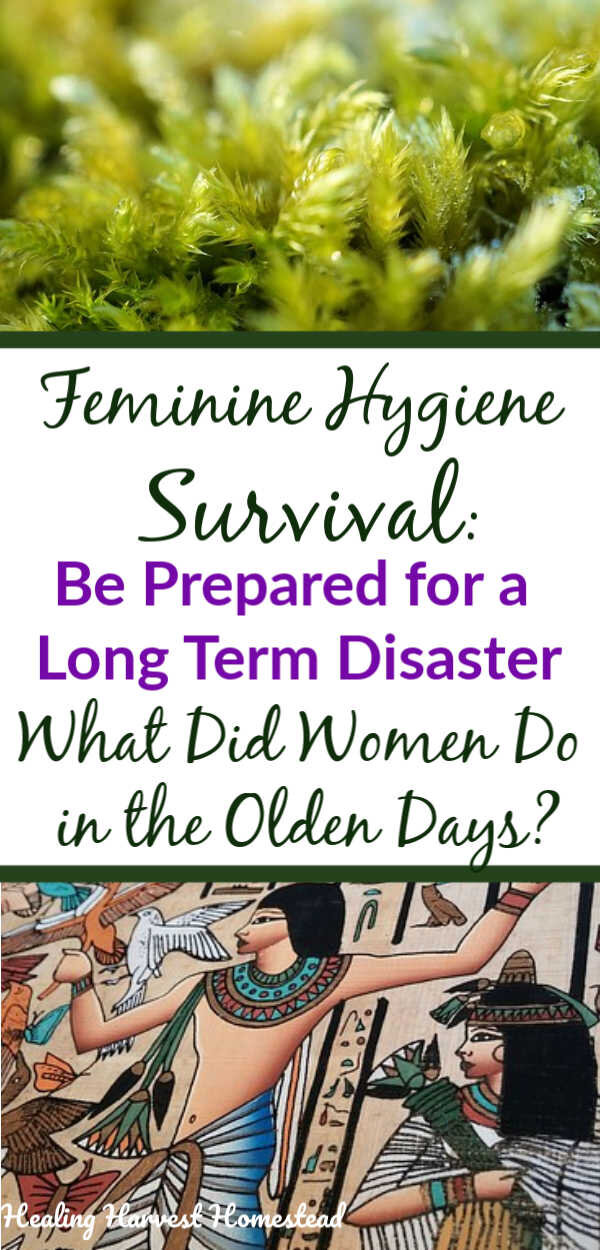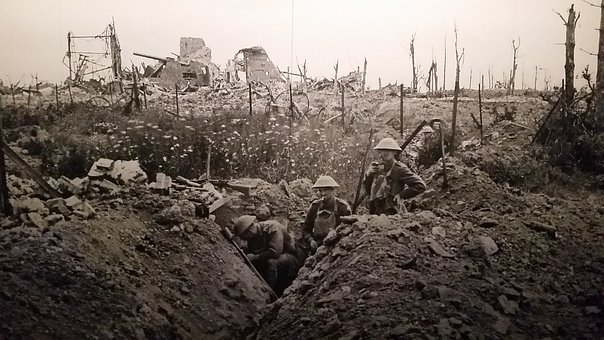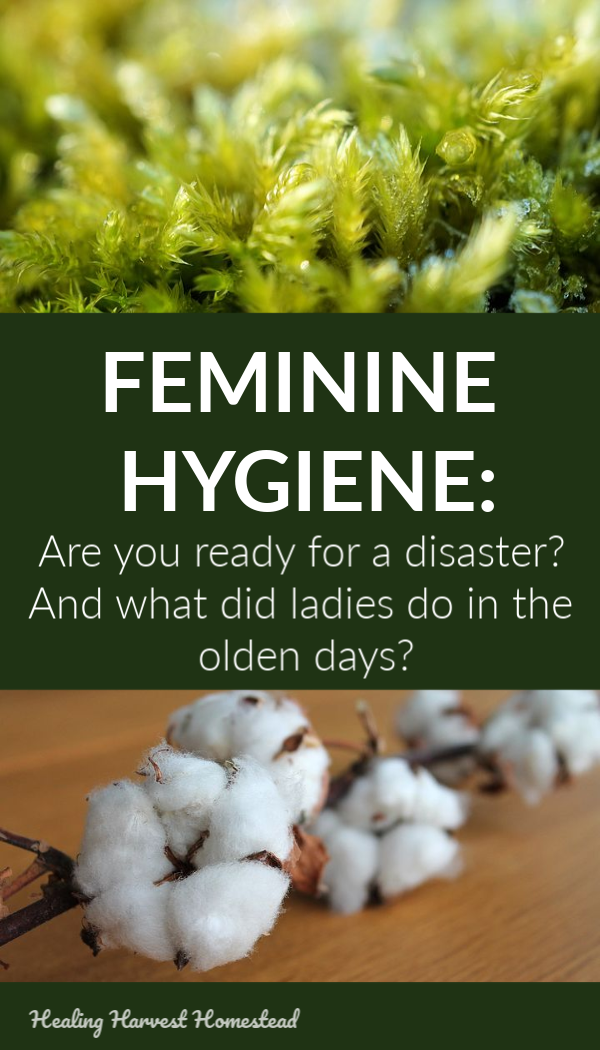Feminine Hygiene Preparedness for Troubled Times
Things are a bit tenuous in the world right now, and it’s time to begin considering your preparedness efforts if you’re able to. Not in a crazy “Dooms Day” way, but just with the thought in mind that we may experience supply chain deficiencies at some point again. One of the things to consider for women’s preparedness is feminine hygiene.
When I was growing up in the sixties and seventies, there were only two options I was aware of for absorbing menstrual flow--pads and tampons. Now we have other options, thank heavens. Here are things to consider about what to do about menstruation in a long term disaster situation?
First, read on for a little fun “period” history!
These are some questions I have been asked recently, so I decided to do a little research on what women did in the olden days before pads and tampons, modern day options, and how to be prepared for "that time" in a disaster situation.
Here is a (sort of) funny story to start off this unusual topic. When I was a young teen, I had been menstruating for several months, gosh, maybe a year, and my mom was taking me and my friend to school one day.
The subject of tampons came up, and my friend mentioned what she used, and I mentioned what I used, and my mom FREAKED out! Because I admitted to using tampons, she told me I wasn't a virgin anymore... Man, did I hear it!
Just a little childhood trauma….
I am one of those people who couldn't stand wearing a pad--it felt like a diaper. So, even at a young age, I opted for tampons, like many of my friends at that time. I am sure I was still a virgin, though, as a tampon was the only item allowed admission back then.
But I digress….
How do you prepare for your cycle when a disaster strikes? What are some other options to commercially available tampons and pads?
Think about modern disasters in our fairly recent lifetime---Hurricane Katrina, the Syrian refugee crisis, the women pouring in over the Southern border, and other disaster situations that involve people not being able to go to the store for items they typically use. What do women do?
If you’re a woman, a man with females in your life, have young girls who haven't begun menstruating yet, or to be “socially correct” are a “menstruator,” you should probably give some thought to preps for feminine hygiene. This is an area that is often forgotten in the prepping mindset.
Even if you DON’T have ladies in your life, you should consider some of these options because you’ll have a bonanza in barter items if you have these on hand.
FTC Disclosure: There are affiliate links scattered throughout this article. If you click through and make any kind of purchase, I may earn a small commission at no extra cost to you.
Ready to start using effective herbal remedies with common and easy-to-find herbs? This guide covers 10 herbs and includes a handy cheat sheet for reference! It’s perfect for your home apothecary or kitchen! Click here to get your FREE copy now!
Let history be a guide for female hygiene needs in case of a disaster or long term survival. Find out how women dealt with their periods throughout history, plus lots of ideas for how to be prepared for a short-term or long-term emergency. Even if you’re a man, you need to be prepared---so your ladies don't have to use moss! Great barter item ideas. #emergency #period #menstruation #femininehygiene #disaster #preparedness #survival #homeremedy #healingharvesthomestead
A History of Menstruation Hygiene: What Did Women Do in the Olden Days for Their Periods?
Let's start out with a little history about what women did in the "olden days" to take care of this time of the month. This is a question I have often had, so I did some research. The results were a bit surprising!
Ancient times:
There were no pads or tampons available. It's likely women in these days actually had fewer periods than modern women have because nutrition wasn't as good, and life expectancies were not as long.
There is evidence women used things such as moss, papyrus wrapped around wood pieces, or wool, paper, or animal skins. Sounds like each woman got pretty creative in these days and handled business for herself.
In some cultures, women were considered "unclean" or "impure" during their time of the month and were actually separated from men. How would that make you feel, sister?
1700 and 1800's:
Depending on your status, a woman during this time period may have access to rags, which they washed and reused. However, if you were poor, living in a rural area, or otherwise didn't have the means or luxury to use rags needed for other things, you might just have let your flow drip onto your clothes.
Some women even wore darker garments so the stains wouldn't be as evident. I'm sorry. I can't even imagine this. Can you?
Common items for females to use during ancient times may have included soft papyrus, moss, and other natural things available.
Early 1900's:
Pads were finally invented. However, these were held in place by suspender-type straps or large thong type contraptions. Essentially, if you wore one of these, you were wearing a large diaper.
I guess I'm starting to understand one of the reasons why women wore dresses, and pants didn't become a "thing" until the 1930's. Wow.
During WWI:
During World War I, there are stories about French nurses using the bandages meant for wounds to help absorb menstrual flow. This is probably how the modern day pad came about. The Kotex company decided to put Curads on sale for women's times. These were worn with a reusable sanitary belt, and the "bandage" was safety pinned in.
Ready to learn herbalism, aromatherapy, and natural living? Check out our School of Botanical Arts & Sciences (SOBAS) by Healing Harvest Homestead! There’s something for everyone there!
1920's and 1930's:
Companies were really starting to get inventive. The first tampons were put on the market by the Tampax company and the first menstrual cup was invented and put on the market for women.
Despite these new advances in menstrual technology, most women still used pads or rags.
Into Modern Times:
Tampons and pads evolved over time to become more and more discreet. Also, tampon marketing became more aligned with women's desire to remain active and have a "normal" life on their periods, so super absorbency and "sport" models emerged.
You can see the evolution of menstrual products has created quite a few luxurious options for women these days! But what will happen in a disaster situation? How does a woman prepare for hygiene matters in case of a disaster?
Click here to get your 12 page Herbal Remedy Guide for 10 easy to find herbs and remedies you can make today. It’s a perfect reference for your kitchen or home medicine chest. Click here to get your FREE guide now!
Can you just imagine using leaves, grass, or moss during Aunt Flow's arrival? It's better to be prepared, don't you think?
How to Prepare for Menstruation During a Short or Long Term Disaster:
1) Store Them Up: (stockpile for the short term)
It's always a good idea to have several weeks of supplies, just in case. For things like monthly occurrences, it's just wise to be ready, and having a stockpile that will last for a bit is an extra good idea. Stock piling is a good option for shorter term prepping.
Especially if you have young girls in your family or may be welcoming others to share your preps, it's a good idea to be ready!
Another thing to consider in the case of feminine supplies is their value as a barter item. Trust me: Ladies/families who are not ready in this regard, or who have given little thought to this area will be ready to perhaps trade for something of value.
However, in the event of a major disaster that lasts longer than just a couple weeks, stockpiling a supply may not be enough....
That brings me to:
2) Reusable Options--External Menstruation Protection
Having reusable options for this time of the month on hand is a great idea for long-term disaster prepping. While historical options like using moss, grass, or papyrus are intriguing, I don't think most of us will want to use these methods during Aunt Flow's visit. Here are some other more comfortable reusable options to consider for the long-term disaster:
Cloth Pads-Commercial:
These are similar to the popular "nappies" or reusable baby diapers made from cloth. You can purchase reusable pads, like these from Amazon, and if you have white vinegar, hydrogen peroxide, bleach, lots of sunlight (which kills germs) or other items like pine oil on hand that will kill bacteria, these could be a handy option for including in the wash, especially if hand washing.
This option from Heartfelt have a charcoal layer, and handily snap into place around the crotch of your undies!
Cloth Pads--DIY:
There are some great DIY options for making your own menstrual pads, if you are into this sort of thing. Although I'm a big DIY'er, I admit I have not attempted this. Actually, I still need to learn to sew well enough to make handy things like cloth pads. It's on the list of new things to learn, my friends!
Here are some patterns you might enjoy: Jan Andrea at Home on the Web, She Who Runs in the Forest (pictures, not patterns), and Adahy's Circle Pads.
During WWI, it's believed French nurses were using bandages meant for war wounds to absorb menstrual flow. This led to the first commercially available pads that were safety pinned to underclothing.
3) Reusable Options--Internal Menstrual Protection
Menstrual Cups:
Menstrual cups are making a comeback from the 50's through 70's, when they were first introduced. They didn't sell well in those days because women were so enamored with the new disposable modern options.
However, with the more recent environmental focus on going green and reducing waste, menstrual cups are becoming a great option! They also remove the need to keep buying expensive disposable tampons.
Here are a couple of options I've either tried or heard about: The Diva Cup and The Athena Cup. If you are going to purchase a menstrual cup, be sure to take a look at sizes and post- or pre- childbirth options. If you are getting ready for a disaster, you might just want to have several options on hand, just in case, and depending on the females in your life.
Sponges:
Yep. Sponges. These little throwbacks from ancient times are also making a resurgence today, although I suspect they are at least a little more sanitary in these modern times. These sea sponges are inserted and absorb rather like a tampon. They can then be cleaned and reused.
I've never used these, but here are a couple of options if you are interested in a more "natural" method: The Sea Pearl Sponge Tampon and Natural Sea Tampons by Poseidon.
Safety Note: In researching these different options, I came across information that cautioned the use of reusable sponge tampons because of bacteria. Just do your research and make choices good for you.
Homemade Tampons--DIY:
Yes, there are really some DIY plans out there for homemade tampons. Again, I have not tried any of these, but here is a short list of options, if you want to give homemade tampons a try: With a Tangled Skein has plans for knitted tampons and these directions using paper towels (which could be adapted to cloth, I believe.)
4) Wetbags:
If you are planning to prep with reusable options, you might want to consider making or buying some wetbags for used items until you can get them washed. Here is a cute plan for a homemade Wetbag, and if you are not into the DIY, you can buy some nice ones on Amazon.
These days, you can choose from commercially available reusable or disposable options....or you can DIY! Either way, you need a plan!
Click here to get your FREE 24 page book with recipes about How to Relax Using Herbs and Oils….It’s a wonderful resource!
Herbs & Essential Oils for Your Period and PMS
Cramping and PMS are also worth mentioning as something to consider in your prepping for feminine needs. This time of the month is SO miserable for many women, and if you are a man reading this: Yes, PMS and discomfort are realities for many women. Therefore, it's a great idea to consider some options to have in your preps for this time.
Herbs:
Herbs are especially wonderful, especially if you live in an area where medicinal herbs grow well, or you are planning to grow your own (like I do). My favorites for tincturing are Cramp Bark and Valerian. That link is to Starwest Botanicals, my favorite place to buy bulk herbs.
Here are some Amazon options: Cramp Bark Tincture and Valerian Tincture.
Note: Cramp Bark is an anti-spasmodic and helps with cramping. Valerian is a sedative herb, and will help relax the body and nervous system. If you need to be active, save the Valerian for night time in conjunction with Cramp Bark.
My personal favorite go-to herbs during this time is Cramp Bark Tincture and Willow Bark Tincture during the day. At night, I'll use Cramp Bark, Willow Bark, and Valerian. I sleep like a baby, even with cramping!
Essential Oils:
You'll have to stockpile these, unless you have a way to distill your plants to obtain the essential oils, which most of us don't. Luckily, most essential oils have a fairly long shelf life if stored properly (two to 20+ years!), and according to Dr. Tisserand (Essential Oil Safety Course), if the bottle is unopened, the start date for shelf life countdown is at the time it’s opened. For the best and longest storage, store most essential oils in a refrigerator or a cool room.
My favorites for use during menstrual periods are Clary Sage, Lavender, Eucalyptus, Ginger, Fennel, and Chamomile. You can mix these together to create a very good blend to rub on your abdomen for cramps.
If you don't want to make your own essential oil blend, you can try these ready made blends: Plant Therapy has a roll-on set for women, and their Balance Blend is great. Just search for "women" on their site, and these will show up.
Rocky Mountain Oils is another one of my favorite companies for essential oils.
Find out more information about the importance of choosing quality aromatherapy companies PLUS a huge list of companies personally vetted by me. I am NOT an affiliate for 95% of these companies….but I’m passionate about only sharing safe sources with sustainability and fair trade in mind. Shopping Guide—-Just scroll about halfway down the page for the list.
You might also be interested in these articles about essential oils:
What is the best way to diffuse essential oils, and
how do you find a good essential oil company that won't kill your pocket book?
Don’t forget to click here to have your FREE Herbal Remedy Guide sent to your inbox now! You’ll love to have this guide in your kitchen or home apothecary! And…it’s free!
Final Thoughts About Being Prepared for Feminine Hygiene Needs in Case of a Disaster
Female needs are often overlooked in the prepping mindset of survival in the event of a disaster. However, it's an important thing to be ready for. Cleanliness is vital in disaster situations, and this time of the month can often feel rather unclean, especially if you don't have a plan in place.
I'm often called a "worry wort," and that may be true---but I love being prepared for anything. It's just a good feeling. What do you think? I'd love to know your thoughts, so please leave a comment, questions, etc. in the comments section!
You may also enjoy these related articles:
How to Get Your Food Storage Ready in Case of a Disaster,
140+ Emergency Items You Should Keep on Hand, and
Stop Bleeding Fast: How to Make Your Own Quikclot.
Leave a comment below! I’d love your thoughts, especially since I’m now a post-menopausal granny, and perhaps a bit out of touch with current period trends….
Hugs, Health, and Self-Reliance,
Heidi
P.S. If you haven't signed up for our newsletter, I hope you'll join our community! When you sign up for the newsletter, you’ll also get access to the free and growing Resource Library that contains tons of printables, eBooks, and guides for your self-reliance journey!
Just complete the form below:
Sources:
http://metro.co.uk/2016/05/20/why-you-shouldnt-use-sea-sponges-as-a-natural-alternative-to-tampons-5894193/
https://www.hercampus.com/health/physical-health/how-girls-handled-their-periods-throughout-history
http://www.smaggle.com/history-of-feminine-hygiene-products/
https://www.thethings.com/15-things-women-actually-used-before-tampons-came-to-the-rescue/
Disclaimer:
I am not a medical doctor, and in no manner, stated or implied, is any information in this article or any other of my verbal or written publications meant to treat, cure, diagnose, or prevent any disease or health issue. Please seed advice from a medical professional for concerns. These statements have not been evaluated by the FDA.
PIN FOR LATER:
Have you ever wondered what women during their “time of the month” in the olden days? This is likely how we are going to have to deal with feminine hygiene and our period in the event of a long term or short term emergency disaster. Here is a history of menstruation solutions and how to prepare for a disaster in this regard. #femininehygiene #menstruation #period #whattodo #survival #preparedness #emergency #disaster #healingharvesthomestead









